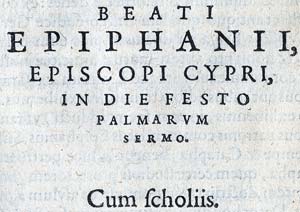The Feast of Palm Sunday
"Die festo palmarum" is the Christian feast day of Palm Sunday, celebrating the day when Jesus rode into Jerusalem on a donkey, while the people spread palm tree fronds in his path. It is a "movable feast" (not on a fixed day each year) that is linked to the date of Easter; it is "the sixth and last Sunday of Lent and beginning of Holy Week, a Sunday of the highest rank, not even a commemoration of any kind being permitted in the Mass. ... The Greeks celebrate the day with great solemnity; they call it kyriake or heorte ton baion or heorte baiophoros or also Lazarus Sunday, because on the day before they have the feast of the resuscitation of Lazarus. The emperors used to distribute branches of palm and small presents among their nobles and domestics. The Latin liturgical books call it Dominica in Palmis, Dominica or Dies Palmarum. From the cry of the people during the procession the day has received the name Dominica Hosanna or simply Hosanna (Ozanna). Because every great feast was in some way a remembrance of the resurrection of Christ and was in consequence called Pascha, we find the names Pascha floridum, in French Pâques fleuries, in Spanish Pascua florida... The palms blessed on Palm Sunday were used in the procession of the day, then taken home by the faithful and used as a sacramental. They were preserved in prominent places in the house, in the barns, and in the fields, and thrown into the fire during storms. ... From the blessed palms the ashes are procured for Ash Wednesday." (Catholic Encyclopedia)
The Text and its Author
The text given here is a translation by Ponce de Leon from the original Greek into Latin. A preface to the text is addressed to the reader (lectori), followed by a dedication of the text to Pope Sixtus V (Sanctissimo D[omino] N[ostro] Sixti V) which Ponce de Leon signs "humble servant" (humilis seruus). This is followed by the "sermo" (homily) in both Greek and Latin on facing pages. The "scholia" at the end provides Ponce de Leon's notes on the translation.
It is uncertain whether Epiphanius actually wrote this homily; it has been suggested that an unknown author ("pseudo-Epiphanius") wrote five of the homilies ascribed to Epiphanius.
Manuscript Sources
In the "Lectori" (page 110) Ponce de Leon indicates where he obtained the text of the Sermo. "The original text of the Sermo came from and 'old' Greek manuscript in the library of Cardinal Carapha (Caraffa). The transcription was made and forwarded to the editor by a friend, the Dutch humanist, gerardus Vossius." - Voet, v. 2, p. 863.

